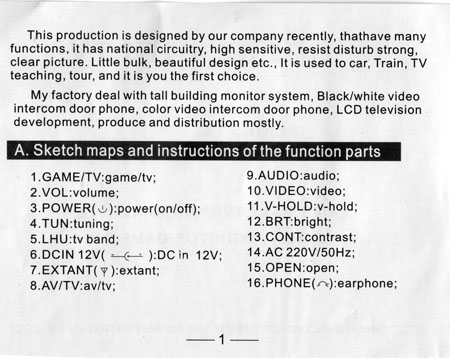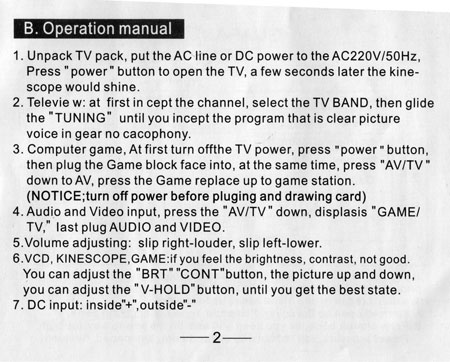|
|
|
most broken English
Friday, February 9 2007
I took delivery of a tiny black and white television set today. I'd bought it for about nine dollars on Ebay with the intention of using it as the display for the retro-cum-computer home stereo I'm building. It's a no-name Chinese import that came with a user's pamphlet written in the most broken English I've ever seen in print. It's a marvel to behold, so I now include it in its entirety.






This pamphlet was obviously written and copy edited by people with almost no exposure to English. I think if I had access to the internet I could write a better pamphlet in Mandarin. Even their company slogan failed to get the once-over by an English speaker. It reads, "Thesatisfaction of user is the biggest withest of us." What the hell does that mean? And what is "national circuitry?"
This little teevee, unlike all the teevees I've ever owned, actually came with a composite-in jack. But when I hooked it up to the computer that may one day drive my living room stereo project, it didn't display anything. I found I had to boot up the computer with a different composite monitor attached to the video card, and only once that other monitor was showing a picture could I unplug the cord, plug it into the little teevee, and see the display on that. Clearly the computer needs to sense something in the composite monitor in order to know to send it a signal - and the teevee wasn't doing whatever it needed to do to be sensed. I did some experiments and found that the little teevee worked fine with an old CGA display card, meaning the problem lay in some advanced feature of the fancy VGA card I was using, which has both a composite output and a standard VGA output. I did a bunch of research online to in an effort to discover what my problem was but came up empty handed. No pages mentioned anything about video cards scanning for attached composite monitors; you'd think composite monitors would be far too primitive to require such fancy treatment. In the end I sent emails to two (1, 2) retro display experts. [They both got back to me within 24 hours, both saying the same thing: modern video cards with composite outputs might well check resistance on the composite cable to see if there is a composite monitor attached, and my teevee probably didn't have enough resistance to be discovered. They suggested I try putting a 75 ohm resistor between the composite tip and the grounded shield. It worked!]
In an experiment today I heated the laboratory exclusively with hot air from the woodstove. Since the woodstove and the laboratory are about sixty feet and a floor apart, to get the hot air into the laboratory, I had to use a fan. I propped one in the angle support of a shelf brace near the top of the laboratory door so it would pull in air from near the teevee room's ceiling, which itself is heated indirectly by hot air rising up the stairway from the living room.
Outdoor temperatures were in the teens and low twenties, but using only a fan I was able to raise the laboratory's temperature from the low fifties to about 62. That's a little cold for my blood, so I donned layers (including a hat and a scarf) so I'd be comfortable as I worked. I'm actually kind of spoiled at this time of year by the ease of hydronic heat; in October before I turned on the boiler I routinely did work in the laboratory when temperatures were in the low fifties. I remember back then that the worst thing about those temperatures was the stiffness it brought to my fingers. At Fahrenheit 62, though I might need layers, my fingers are fine.
In the wee hours of the morning I went on another raid of the abandoned tree scraps piled along the Esopus just north of Old Hurley. I ranged wider than I have in the past, but all the scrap wood I found was junk: Tree of Heaven, various evergreens, and huge pieces of cottonwood. But, since cottonwood is proving more useful than expected, I wrestled a huge piece of it into the car and then added a number of 10 to 16 inch thick disks cut from a pine or spruce that had been 21 inches thick but only grown forty growth rings.
For linking purposes this article's URL is:
http://asecular.com/blog.php?070209 feedback
previous | next |





